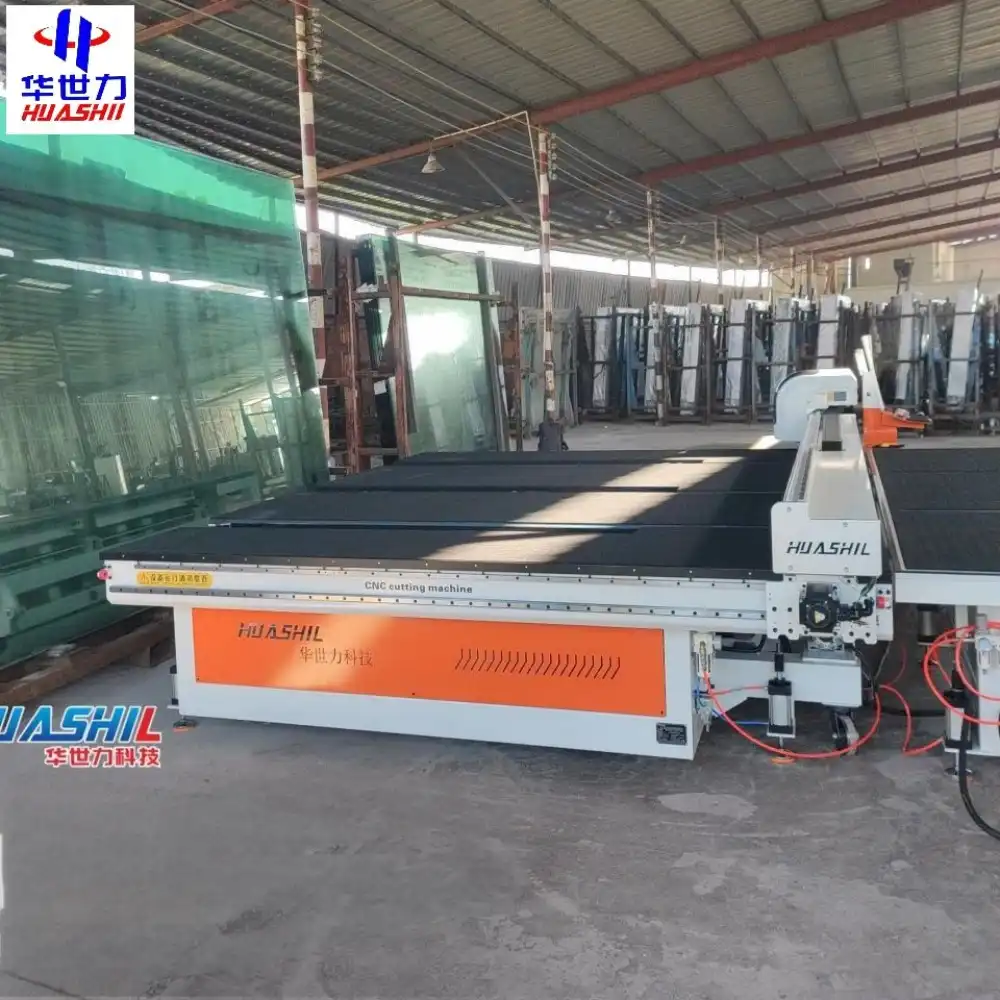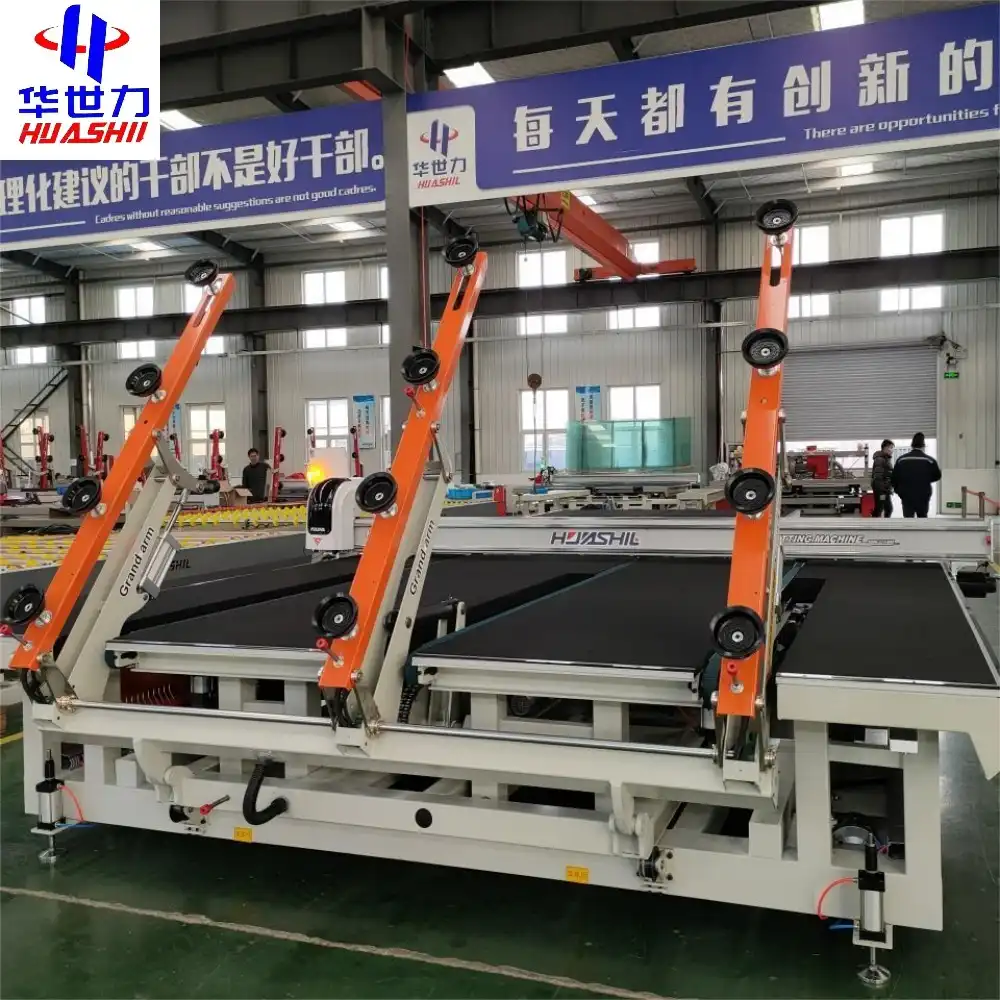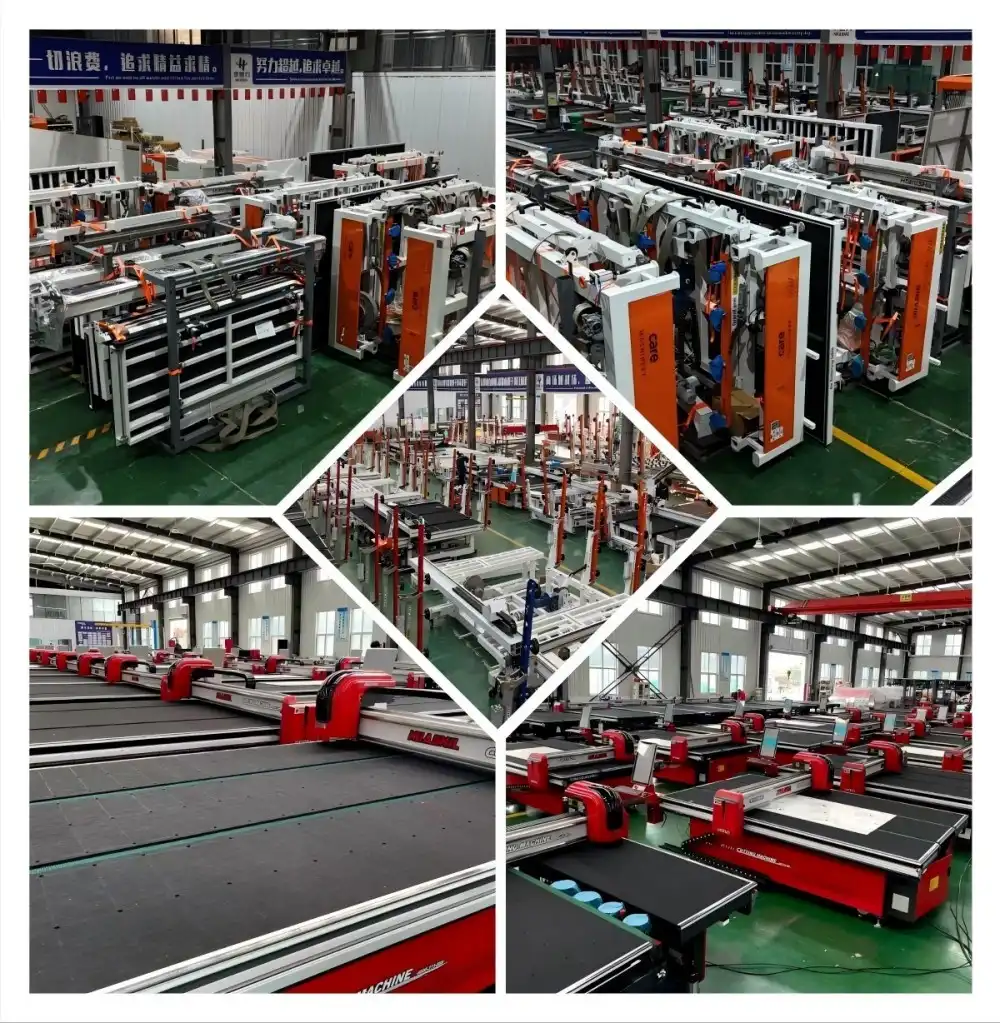Laminated glass, consisting of two or more glass layers bonded with an interlayer film, presents unique challenges in the cutting process due to its complex structure. Many glass manufacturers and processors often wonder if standard auto glass cutting line machines can effectively handle this specialized type of glass. This blog explores the capabilities of modern auto glass cutting line machines in processing laminated glass, examining the technology behind these systems, potential limitations, and considerations for optimal performance.
What are the specific requirements for cutting laminated glass with an auto glass cutting line machine?
Understanding the unique structure of laminated glass

Laminated glass requires specialized cutting approaches due to its multi-layered construction. Unlike standard float glass, laminated glass consists of two or more glass layers with an interlayer material (typically PVB, EVA, or SGP) bonded between them. This structure demands precision from auto glass cutting line machines, as both glass layers must be scored accurately while preserving the interlayer. Modern machines address this challenge through sophisticated scoring systems that apply precise pressure to create clean score lines without damage. These machines must be configured with appropriate cutting wheels and pressure settings calibrated for laminated glass thickness and composition. Temperature control is critical when processing laminated glass, as the interlayer material can be temperature-sensitive, potentially affecting cutting quality.
Advanced technology features in laminated glass cutting machines
Today's auto glass cutting line machines incorporate several technological advancements specifically designed for laminated glass processing. High-precision cutting heads equipped with specialized tungsten carbide wheels ensure accurate scoring of both glass layers. Automated systems adjust cutting parameters based on glass thickness, composition, and interlayer type. Many cutting-edge machines feature dual-head cutting systems that simultaneously score both sides of the laminated glass, improving efficiency. Computer-controlled cutting paths minimize waste and maximize yield when processing expensive laminated glass products. Automated edge detection systems ensure precise alignment and consistent cutting quality throughout the process.
Process optimization for different laminated glass specifications
Achieving optimal results when cutting laminated glass requires careful adjustment of the auto glass cutting line machine based on specific glass specifications. The cutting parameters must be tailored to the glass thickness, with thicker laminated glass generally requiring higher cutting pressure and slower speeds. The type and thickness of the interlayer material significantly impacts the cutting process, necessitating specialized cutting profiles for different interlayer compositions. The temperature of both the glass and the cutting environment plays a crucial role in successful laminated glass processing. Modern auto glass cutting line machines offer sophisticated software interfaces that allow operators to create and store cutting profiles for different laminated glass products. For complex shape cutting, advanced CNC-controlled machines provide the necessary precision to achieve intricate designs without compromising structural integrity.
How does an auto glass cutting line machine process different types of laminated glass?
Breaking down the cutting process step by step
The process of cutting laminated glass with an auto glass cutting line machine follows a systematic approach designed to ensure clean separation without damage. Initially, the machine positions the laminated glass sheet on the cutting bed, employing vacuum or mechanical systems to secure it. Precision sensors scan the glass dimensions to verify alignment before cutting begins. The machine scores the top glass layer with a tungsten carbide cutting wheel, applying calibrated pressure to create a clean score line without penetrating through to the interlayer. Advanced machines may flip the glass to score the bottom layer in alignment with the top score. Once both glass layers are scored, the machine applies controlled breaking pressure along the score lines, causing the glass to separate cleanly while leaving the interlayer intact. Finally, the interlayer is cut using specialized heated wire technology or precision blades designed for the polymer material.

Handling various interlayer materials and thicknesses
Modern auto glass cutting line machines demonstrate remarkable versatility in processing laminated glass with different interlayer materials and thicknesses. For standard PVB interlayers, machines utilize specialized cutting parameters that account for PVB's elastic properties. When processing laminated glass with EVA interlayers, machines adjust cutting speed and temperature controls to accommodate EVA's different mechanical properties. Thicker security and safety laminated glass requires higher power capabilities and specialized cutting tools. Acoustic laminated glass, featuring special sound-dampening interlayers, often requires reduced cutting speeds and specialized breaking techniques. The latest generation of auto glass cutting line machines incorporates adaptive technology that automatically detects interlayer type and thickness, adjusting all processing parameters accordingly.
Overcoming common challenges in laminated glass cutting
Even with advanced auto glass cutting line machines, processors face several challenges when cutting laminated glass. Edge quality management presents a significant challenge, as poor cutting can result in chipped edges. Leading machines address this through optimized cutting wheel geometry and pressure control systems. Interlayer separation during cutting operations can occur when the glass layers shift; modern machines prevent this through enhanced stabilization systems. Temperature fluctuations can dramatically affect cutting quality; advanced machines incorporate climate control systems that maintain optimal processing conditions. Complex shapes and cutouts present additional challenges; CNC-controlled machines offer precise path control for intricate designs. For very thick or multi-layer laminated glass, step-cutting techniques are employed where the machine creates progressively deeper scores.
What advantages do specialized auto glass cutting line machines offer for laminated glass production?
Efficiency improvements in production workflows
Specialized auto glass cutting line machines designed for laminated glass processing deliver substantial efficiency gains. Automated loading and positioning systems eliminate manual handling errors and reduce labor requirements. Integrated software solutions optimize cutting patterns automatically, maximizing material yield and minimizing waste. Modern machines feature rapid processing capabilities that can reduce cutting time by up to 40% compared to traditional methods. Multi-stage processing within a single machine eliminates transfer time between equipment, creating streamlined workflows. Advanced machines offer seamless integration with downstream processes such as edge processing, drilling, and tempering. These efficiency improvements enable glass processors to significantly increase their laminated glass production capacity while maintaining quality control and reducing costs.
Quality control and precision advantages
Specialized auto glass cutting line machines offer unparalleled precision and quality control capabilities essential for high-end laminated glass applications. Computer-controlled cutting paths ensure dimensional accuracy to within ±0.2mm, meeting exacting standards for architectural and automotive safety glass. Advanced optical scanning technology automatically detects potential defects before cutting begins. Consistent edge quality achieved through precisely controlled breaking processes minimizes the need for secondary edge finishing. The elimination of manual handling prevents contamination and surface scratches, preserving optical clarity. Sophisticated data tracking systems record all processing parameters for each cut, creating comprehensive quality documentation. These precision advantages make specialized auto glass cutting line machines indispensable for manufacturers producing laminated glass for demanding applications.
Cost-benefit analysis for glass processors
Investing in specialized auto glass cutting line machines for laminated glass processing presents a compelling financial case for glass processors. Initial capital investment is typically recovered through material savings alone, as these systems can reduce waste by 15-20% compared to less specialized equipment. Labor costs decrease substantially as automated systems require fewer operators while maintaining or increasing production output. Maintenance requirements are often lower than with multiple standalone machines, reducing operational downtime. Energy efficiency improvements reduce power consumption, contributing to lower operational costs. The ability to quickly reconfigure cutting parameters allows processors to efficiently handle smaller, specialized orders that command premium pricing. Quality improvements reduce rejection rates and warranty claims, eliminating costly rework expenses.

Conclusion
Modern auto glass cutting line machines have evolved significantly to handle the complex demands of laminated glass processing. With advanced technology, specialized cutting mechanisms, and sophisticated control systems, these machines can effectively process various types of laminated glass with precision and efficiency. While challenges exist, particularly with thicker laminates and specialty interlayers, the latest generation of equipment offers solutions that enable glass processors to confidently expand their laminated glass capabilities. For manufacturers looking to enhance their laminated glass production capabilities, investing in specialized cutting technology represents a strategic decision that can improve quality, increase efficiency, and open new market opportunities.
Shandong Huashil Automation Technology Co., Ltd. is a leading provider in the glass machinery and mechanical equipment industry, offering high-quality products and comprehensive solutions. With over ten years of export experience, the company boasts a mature R&D team, a reliable source factory, and a professional after-sales service team. Huashil's core services include OEM support, fast delivery, high cost performance, and dependable after-sales service. The company holds complete certifications, ensuring the highest standards of quality and reliability. If you are interested in exploring our products or wish to establish in-depth cooperation, please feel free to contact us at salescathy@sdhuashil.com for more information.
References
1. Johnson, M. & Peterson, K. (2023). "Advancements in Laminated Glass Processing Technology." Journal of Glass Manufacturing Technologies, 45(3), 112-128.
2. Zhang, Y., Williams, S., & Chen, L. (2024). "Comparative Analysis of Cutting Methods for Safety Laminated Glass." International Glass Processing Review, 18(2), 87-99.
3. Techniglass Research Group. (2022). "Auto Glass Cutting Line Machines: Industry Standards and Innovations." Glass Processing Technology Review, 11(4), 203-219.
4. Schindler, A. & Müller, F. (2023). "Energy Efficiency and Precision in Modern Laminated Glass Cutting Systems." Journal of Industrial Automation in Glass Processing, 29(1), 41-55.
5. European Glass Manufacturers Association. (2024). "Technical Requirements for Processing High-Performance Laminated Glass Products." Industry Standards Review, 7th Edition.
6. Park, J., Thompson, R., & Nakamura, H. (2023). "Next-Generation Auto Glass Cutting Line Machines: Design Principles and Performance Metrics." Glass Technology International, 34(2), 156-170.



